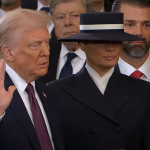
Navigating the Impact of Trump’s ‘Liberation Day’ Tariffs on Global Markets
Trump’s “Liberation Day” tariffs—yeah, those—have rattled global markets… big time. At Everyday Next, we’re all over it, keeping tabs on the fallout from this gutsy trade move.
These shiny new tariffs? They’re flipping international trade on its head and firing up reactions from the big dogs in the global economy. Our deep dive? It cuts through the chatter, looking at the here-and-now impacts, the what-could-happen consequences, and what it all means for anyone with a business or a credit card. Buckle up.
What Are Trump’s ‘Liberation Day’ Tariffs?
Alright, Trump’s ‘Liberation Day’ tariffs-what’s the deal here? It’s a seismic shift, folks, in U.S. trade policy. So, Trump’s latest play… well, it slaps a minimum 10% tariff on goods from pretty much everyone else on the planet (link=https://www.whitehouse.gov/fact-sheets/2025/04/fact-sheet-president-donald-j-trump-declares-national-emergency-to-increase-our-competitive-edge-protect-our-sovereignty-and-strengthen-our-national-and-economic-security/), some getting even more hammering. Picture this: global markets? They’re stumbling like they’ve had one too many at the trade party.
The Nuts and Bolts of the New Tariffs
Here’s how it shakes out-10% is the starting line. Everything headed to the U.S. shore is tagged. But countries lounging on trade surpluses? Ouch. They’re staring down even steeper cliffs. And guess what? Folks around the world are ruffling their feathers, mouthing off about a trade war with Uncle Sam, as Trump’s big bad tariffs stir the pot.
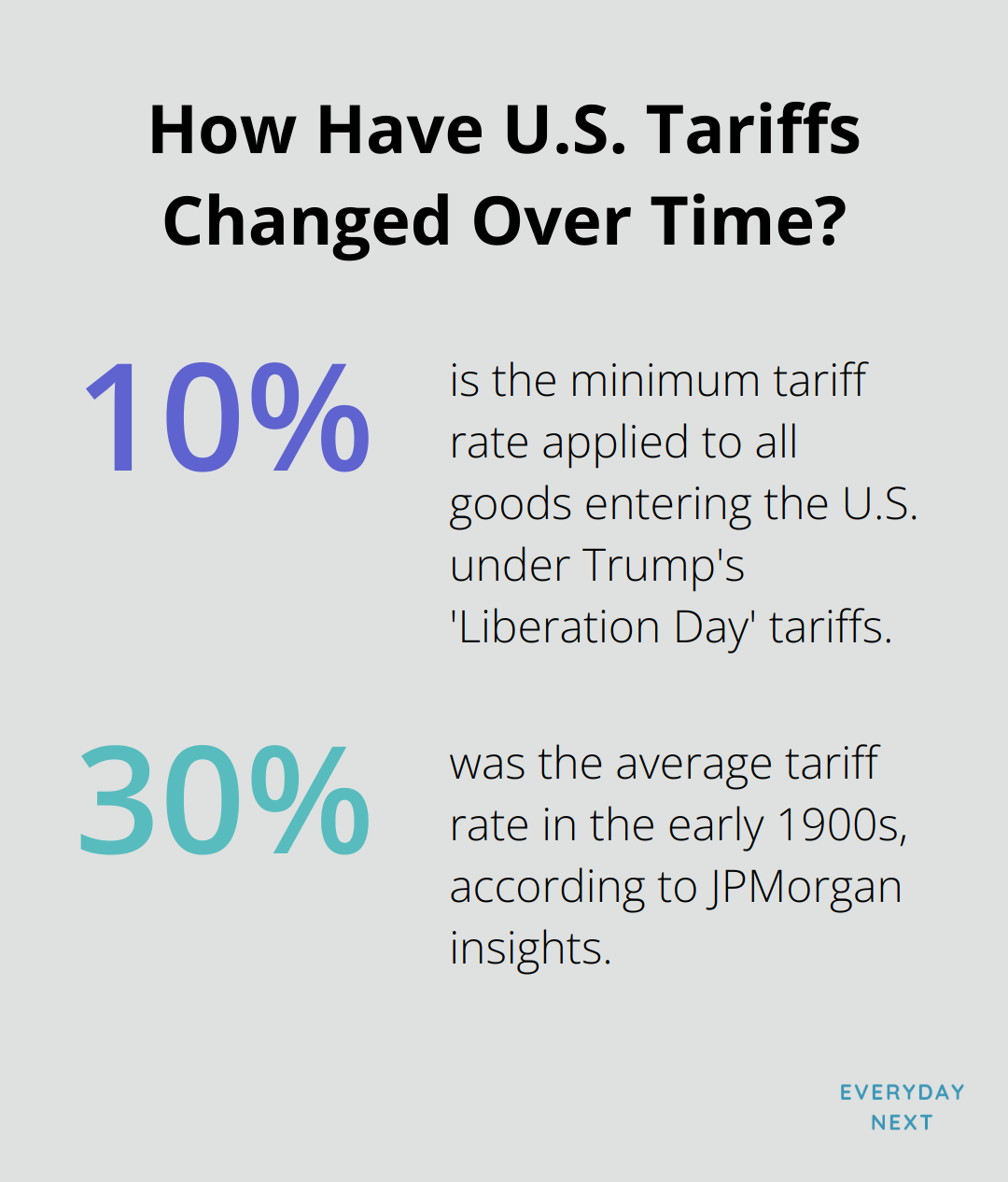
You’re likely to see prices at the checkout jump, right across the board. Imported whips-yep, cars-say hello to price bumps (yeah, middle-class aficionados, that’s your wallets bracing for impact). Joe and Jane Average? They’ll likely see their expenses creep up as these costs echo through the economy’s symphony.
Industries in the Crosshairs
Now, who’s on the front lines? The auto industry, first in the queue, quaking over tariffs hitting their imported buggies. It’s a sweeping impact, top to bottom.
Then there’s construction-a whole lot of pain coming that way. Think home building costs shooting to the moon with pricey raw materials like lumber, aluminum, and steel riding shotgun.
Tech’s in the splash zone too. With a hefty slice of profits jet-setting from overseas, tech titans find themselves exposed in a big way. Higher prices for your gizmos and gadgets? It’s a real possibility on the horizon.
A Historical Perspective
So, these tariffs crank up the U.S. tariff rate to levels our great-grandparents would recognize. Back in the day-early 1900s, to be precise-tariffs bobbed around 30%, but they’ve drifted downward through the years.
Economists are drawing some lines-comparing this to the notorious Smoot-Hawley Tariff Act of 1930, which folks say poured salt in the Great Depression’s wounds. While the contexts diverge, the link underscores just how weighty these tariffs are.
Reaction out there? Fast and far from thrilled. The EU’s mulling over tariffs on U.S. goods. China? Already tossed some retaliatory tariffs back at U.S. imports. It’s a game of tit-for-tat with the potential to snowball into a full-blown trade storm.
As we forge ahead, businesses and everyday folks best brace themselves for some hefty shifts. Next up, we’re diving into how these tariffs have started shaking global markets and what’s in store in the months to come.
How Global Markets React to Trump’s ‘Liberation Day’ Tariffs
So, Trump’s ‘Liberation Day’ tariffs dropped like a bombshell on global markets-it’s chaos out there. We’re talking shocks to stock values, tremors in currency exchange rates, and a whole new landscape for international trade. At Everyday Next, we’re diving into the immediate fallout and the longer-term ripples for investors and businesses across the globe.
Stock Market Turbulence
Boom-global stock markets nosedived after Trump’s tariff news. The Nasdaq Composite plunged 11.4%, clocking its worst 2-day drop since March 2020. Loud and clear, investors are worried.
Tech companies are really in the soup with tariffs-on one hand, higher costs for components, and on the other, supply chain chaos between North America and China. Spicy fact: a juicy 57% of profits for these tech behemoths come from abroad, so they’re extra-vulnerable to these trade tensions.
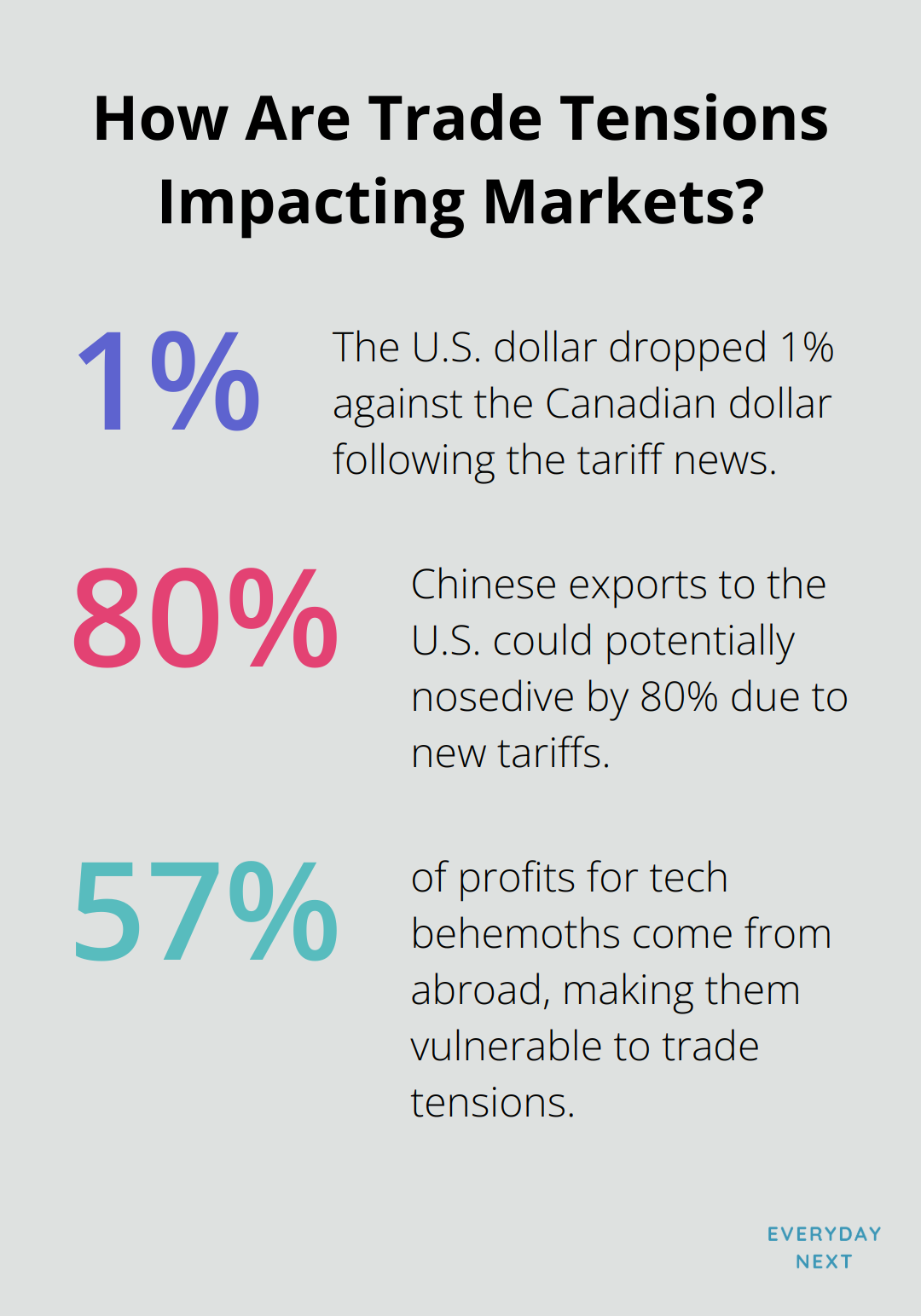
Europe didn’t get a free pass-stocks there dipped 3.6%. Asia? Right behind, with Chinese stocks falling 1.5% and Japanese ones down 3.1%. It’s a good lesson: today’s markets are as connected as earbuds to a smartphone, and U.S. trade actions don’t just stay at home.
Currency Market Shifts
In currency news-the U.S. dollar took a hit, falling against major currencies after the tariff thunder. Down 1.8% against the euro and 1% against the Canadian dollar-a mixed bag for the U.S., really. Exporters might be smiling with more competitive pricing abroad, but ouch, imports just got expensive for American wallets.
Anyone in the international trade game-this is the time to keep a hawkeye on currency swings. Forex is acting like it’s had one too many energy drinks-thrills and spills galore for traders and companies dealing with foreign exchange.
Trade Pattern Disruptions
Talk about shaking things up-the new tariffs are flipping global trade on its head. China, looking at a punishing 54% tariff rate, could see its U.S. exports nosedive by 80%. That’s huge. Chinese manufacturers scrambling for new buyers? You bet-and global supply chains are in for a makeover.
Southeast Asia-it’s all about diversifying trade partners, going global in new ways beyond the U.S. A fresh horizon for businesses aiming to tap into emerging markets.
Meanwhile, the European Union-facing hefty tariffs on its $2 trillion trade with the U.S.-is pondering retaliatory moves. They’ve got $28 billion of U.S. exports in their sights, with industries politicians won’t like seeing targeted. Businesses in those sectors? Time to brace for market mayhem and think about choosing different markets.
With the shifting trade winds, businesses must re-evaluate supply chains and market plans. Tariff-driven cost hikes and uncertainties are pushing companies to rethink sourcing, pricing, and market targeting. The agile firms adapting to this tectonic shift could unearth golden opportunities amid the chaos.
Trump’s ‘Liberation Day’ tariffs don’t just move markets-they send ripples through the economy. Next up, we’re exploring how the major players plan to navigate this earthquake.
How Global Powers Respond to Trump’s Tariffs
So, here we go – Trump’s ‘Liberation Day’ tariffs, they’re shaking up the global economy like a snow globe. Everybody’s scrambling to protect their turf, and we’re seeing international trade dynamics do the cha-cha. Let’s dive into how big players are reacting to this tectonic shift.
China’s Calculated Countermove
China – facing a whopper of a 54% tariff rate. And they’re not just sitting around. Nope, they’re slapping a 34% retaliatory tariff on all U.S. imports, starting April 10, 2025. This move? It’s China basically saying, “Game on.”
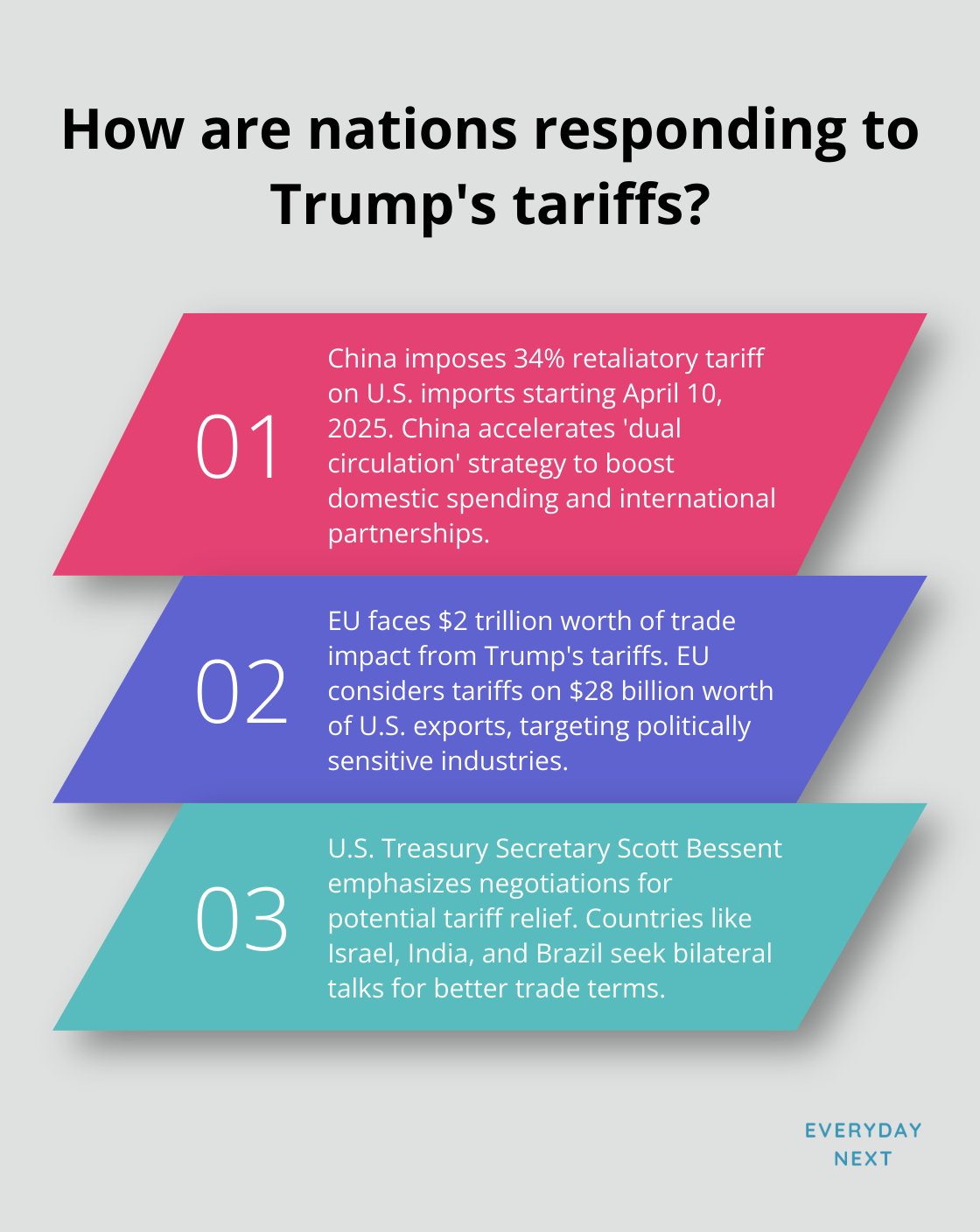
Over in Beijing, they’ve hit the fast-forward button on their ‘dual circulation’ strategy. The strategy? Pump up domestic spending and cozy up to other international partners – less U.S., more everyone else. If you’re doing business in China, it’s time to rethink your game plan. New supply chains? New markets? Get on it.
EU’s United Front
The EU? They’ve got $2 trillion worth of trade in the crosshairs. And let’s just say, they think Trump’s move is like a punch to the gut for the world economy. Now, they’re eyeing tariffs on $28 billion worth of U.S. exports.
Their game plan? Hit America where it hurts – politically sensitive industries. If your business is tangled up in these sectors, start thinking ahead. Scenario planning, market diversification… maybe even some yoga to help manage the stress.
Diplomatic Channels in Overdrive
Despite all the bluster, the diplomats are burning the midnight oil. U.S. Treasury Secretary Scott Bessent is talking up the negotiation angle like it’s the best thing since sliced bread. And maybe, just maybe, there’s some tariff relief on the table for those willing to play ball.
Countries like Israel, India, and Brazil are raising their hands for some bilateral chats. This could be the golden ticket for businesses there to snag better trade terms. Stay tuned – the market access and competitive landscape could be in for a major remix.
Emerging Markets Seek New Alliances
Now, Southeast Asia is stuck in the middle and they’re looking to make new friends. It’s a prime time for businesses to dive into emerging markets or rethink their supply chains.
Take Vietnam – they’re riding a wave of manufacturing growth and are now flirting with the EU and other Asian economies. If your business leans on Southeast Asian manufacturing, keep a close eye on these new trade routes. It’s all about adapting and staying ahead of the curve.
Final Thoughts
So, Trump’s tariffs – what’s the deal there? They’ve flipped global trade on its head, turning the markets into a bit of a rollercoaster. Stock markets? Took a nosedive. Currencies? Playing yo-yo. And those prices on imported goods? Well, they just hit the ceiling. It’s a whole new ball game, folks – businesses have got to shake up their supply chains and think long and hard about their strategies if they want to keep their heads above water.
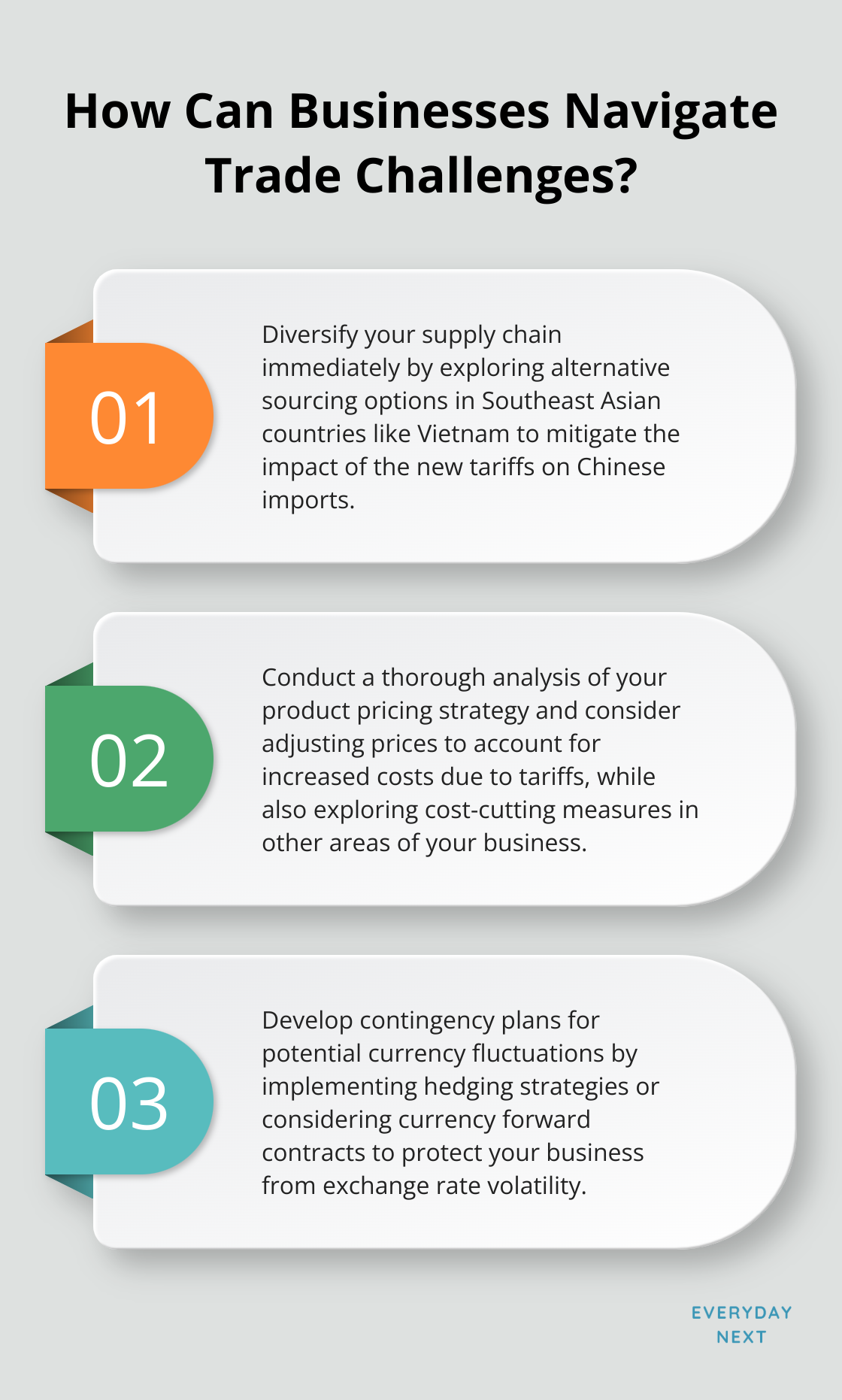
And looking down the road… these tariffs? They could totally rewrite the playbook on global trade. Countries might start buddying up with new partners and spreading their economic eggs across more baskets to dodge future curveballs. A big ol’ trade war? It’s not off the table – and boy, would that gum up the works for global growth, not to mention crank the dial on economic jitters.
Enter Everyday Next, your go-to in these wild times. We’re dishing out insights you need to keep your game tight amidst the chaos. Strategies and tools for both the solo players and the big leagues to roll with the punches in such a topsy-turvy world. Want to catch more tips on turning tricky times into winning opportunities? Come knock on our door at Everyday Next.








